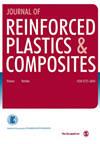使用基于动态力学分析仪的柱弯曲试验研究薄层高应变复合材料的松弛行为
IF 2.2
3区 材料科学
Q3 MATERIALS SCIENCE, COMPOSITES
引用次数: 0
摘要
由薄层高应变复合材料(HSC)层压板制成的可部署空间结构可以紧凑地收放,但在高曲率下长期收放会因松弛而改变其部署形状。本研究采用基于动态机械分析仪的柱弯曲试验(CBT)方法和定制开发的夹具来表征薄层 HSC 的松弛行为。利用薄层单向 IM7/PMT-F7 和 Astroquartz/PMT-F7 预浸料制备了四种层压结构:(i) IM7/PMT-F7 [0°],(ii) Astroquartz/PMT-F7 [±45°],(iii) Flexlam [±45°/0°/±45°] 和 (iv) Flexlam [±45°/90°/±45°]。在试样上依次施加 0.5%、1.0%、1.5% 和 2.0% 的表面应变,持续 100 分钟,每个应变之间有 1000 分钟的恢复期。这种阶跃应变方法分别在 30°C、50°C 和 70°C 温度下进行。松弛结果表明,以纤维为主的试验配置,即 UD IM7/PMT-F7 [0°] 薄片,没有出现可测量的松弛。然而,以基体为主的配置,即 Astroquartz/PMT-F7 [±45°] 薄片和 Flexlam 薄片,则出现了可测量的松弛。与 Astroquartz/PMT-F7 [±45°] 层压材料相比,Flexlam 层压材料的松弛较小,这是因为其中包含了单向 IM7 碳纤维。结果还表明,松弛行为与时间和应变有关,而与温度无关。本文章由计算机程序翻译,如有差异,请以英文原文为准。
Relaxation behavior of thin-ply high strain composites using a dynamic mechanical analyzer based column bending test
Deployable space structures made from thin-ply high-strain composite (HSC) laminates can be compactly stowed, but prolonged stowage under high curvature can alter their deployed shape due to relaxation. In this research, a dynamic mechanical analyzer-based column bending test (CBT) method, with a custom-developed fixture was used to characterize the relaxation behavior of thin-ply HSCs. Four laminate configurations were prepared from thin-ply unidirectional IM7/PMT-F7 and Astroquartz/PMT-F7 prepregs: (i) IM7/PMT-F7 [0°], (ii) Astroquartz/PMT-F7 [±45°], (iii) Flexlam [±45°/0°/±45°] and (iv) Flexlam [±45°/90°/±45°]. Surface strains of 0.5, 1.0, 1.5, and 2.0% were sequentially applied to the specimen for 100-min durations, each separated by a 1000-min recovery period. This stepped strain approach was performed at 30°C, 50°C, and 70°C. The relaxation results indicate that the fiber-dominated test configuration, UD IM7/PMT-F7 [0°] lamina, shows no measurable relaxation. However, the matrix-dominated configurations, Astroquartz/PMT-F7 [±45°] lamina and the Flexlam laminates, show measurable relaxation. The Flexlam laminates show less relaxation than the Astroquartz/PMT-F7 [±45°] lamina due to the inclusion of unidirectional IM7 carbon fiber. The result also indicates that the relaxation behavior is time and strain-dependent, not temperature-dependent.
求助全文
通过发布文献求助,成功后即可免费获取论文全文。
去求助
来源期刊

Journal of Reinforced Plastics and Composites
工程技术-材料科学:复合
CiteScore
5.40
自引率
6.50%
发文量
82
审稿时长
1.3 months
期刊介绍:
The Journal of Reinforced Plastics and Composites is a fully peer-reviewed international journal that publishes original research and review articles on a broad range of today''s reinforced plastics and composites including areas in:
Constituent materials: matrix materials, reinforcements and coatings.
Properties and performance: The results of testing, predictive models, and in-service evaluation of a wide range of materials are published, providing the reader with extensive properties data for reference.
Analysis and design: Frequency reports on these subjects inform the reader of analytical techniques, design processes and the many design options available in materials composition.
Processing and fabrication: There is increased interest among materials engineers in cost-effective processing.
Applications: Reports on new materials R&D are often related to the service requirements of specific application areas, such as automotive, marine, construction and aviation.
Reports on special topics are regularly included such as recycling, environmental effects, novel materials, computer-aided design, predictive modelling, and "smart" composite materials.
"The articles in the Journal of Reinforced Plastics and Products are must reading for engineers in industry and for researchers working on leading edge problems" Professor Emeritus Stephen W Tsai National Sun Yat-sen University, Taiwan
This journal is a member of the Committee on Publication Ethics (COPE).
 求助内容:
求助内容: 应助结果提醒方式:
应助结果提醒方式:


